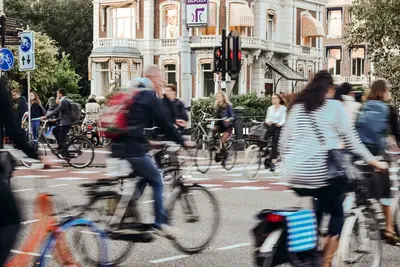Where Do Bicycle Accidents Occur?
According to the CDC, only 1% of all trips in the United States are taken by bicyclists, yet they account for more than 2% of people dying on the roads involving motor vehicles. Annually, nearly 1,000 bicyclists die on US roads, and 130,000 more are injured. The average person might never witness a bicycle accident near them, but they happen more often than you think. Typically, most bicyclists are involved in accidents in some of the following areas:
Urban Areas
Out of all areas for bicycle accidents to happen, they more commonly occur in urban areas, such as towns, cities, and suburbs. Typically, metropolitan areas have high population densities and well-developed infrastructure. The more people there are in these spaces, the higher the risk can be for cyclists to potentially be involved in life-changing accidents involving other vehicles.
While cyclists might not be able to avoid all accidents in urban areas, they might make themselves more visible by riding during daylight hours, wearing reflective clothing and products, and lighting up their bikes.
At Intersections
According to the NHTSA, in 2019 nearly one-third of all cyclist fatalities occurred at intersections. While such accidents can happen for many reasons, studies have found that non-orthogonal intersections are more likely to result in severe injuries than non-orthogonal intersections. Other factors might also play a part, like distracted drivers, cyclists and motorists driving and riding under the influence of drugs or alcohol, and speed.
Bicycle Lanes
Bicycle lanes are areas of roads dedicated to cyclists. While cars may cross bicycle lanes to turn down streets and merge, they are not designed for motorists to use as part of the road. However, some accidents happen in bike lanes due to collisions with cars. Sometimes, drivers perform unsafe lane changes by merging without looking to make sure the bicycle lane is clear. Bicycle lanes might be set up to make commuting by bicycle safer, but they don’t prevent all accidents.
Sidewalks
Many cyclists use sidewalks to make their commute to work and activities safer. If they don’t have to share the road with motorists, they might improve their chances of making it to their destination safely. However, that doesn’t always happen. According to NHTSA data, 10% of fatal bike accidents occur on sidewalks, medians, roadsides, and parking lanes. Most often, these accidents involve other motorists.
Trails
Many cyclists use trails as a safer alternative to riding on the road. However, some bicycle accidents can happen on trails with other cyclists. Typically, cyclists collide with other cyclists on corners. However, in some cases, cyclists don’t make their actions clear with arm movements, causing other cyclists to misinterpret their travel path and collide.
Some municipalities have attempted to make these trails safer by installing bollards made from PVC and other materials designed to reduce the risk of injuries if hit. However, some trails still have steel posts, which can put cyclists at risk of severe injuries if they collide with them.
Bicycle accidents can occur anywhere but they are more likely to happen in urban areas, at intersections, and during rush hour traffic. It is important for bicyclists to be aware of their surroundings, follow traffic laws, and wear proper safety gear to reduce their risk of injury. Cities and local governments can play a role in promoting bicycle safety by providing proper infrastructure such as bike lanes and increased enforcement of traffic laws. By promoting safety awareness among both drivers and bicyclists, we can cultivate a safer environment on the roads and ultimately minimize the number of bicycle accidents.



